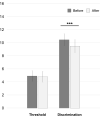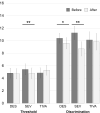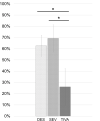Perioperative Anesthesia and Acute Smell Alterations in Spine Surgery: A "Sniffing Impairment" Influencing Refeeding?
- PMID: 35372489
- PMCID: PMC8965841
- DOI: 10.3389/fsurg.2022.785676
Perioperative Anesthesia and Acute Smell Alterations in Spine Surgery: A "Sniffing Impairment" Influencing Refeeding?
Abstract
Medications for general anesthesia can cause smell alterations after surgery, with inhalation anesthetics being the most acknowledged drugs. However, spine patients have been poorly studied in past investigations and whether these alterations could influence the refeeding remains unclear. This research aims to observe detectable dysosmias after spine surgery, to explore any amplified affection of halogenates (DESflurane and SEVoflurane) against total intravenous anesthesia (TIVA), and to spot potential repercussions on the refeeding. Fifty patients between 50 and 85 years old were recruited before elective spine procedure and tested for odor acuity and discrimination using the Sniffin' Sticks test. The odor abilities were re-assessed within the first 15 h after surgery together with the monitoring of food intakes. The threshold reduced from 4.92 ± 1.61 to 4.81 ± 1.64 (p = 0.237) and the discrimination ability reduced from 10.50 ± 1.83 to 9.52 ± 1.98 (p = 0.0005). Anesthetic-specific analysis showed a significant reduction of both threshold (p = 0.004) and discrimination (p = 0.004) in the SEV group, and a significant reduction of discrimination abilities (p = 0.016) in the DES group. No dysosmias were observed in TIVA patients after surgery. Food intakes were lower in the TIVA group compared to both DES (p = 0.026) and SEV (p = 0.017). The food consumed was not associated with the sniffing impairment but appeared to be inversely associated with the surgical time. These results confirmed the evidence on inhalation anesthetics to cause smell alterations in spine patients. Furthermore, the poor early oral intake after complex procedures suggests that spinal deformity surgery could be a practical challenge to early oral nutrition.
Keywords: anesthesia; critical care; fluorinated hydrocarbons; inhalation exposures and halogens; orthopedic procedures; perioperative period and refeeding; smell disorder; spine.
Copyright © 2022 Briguglio, Crespi, Langella, Riso, Porrini, Scaramuzzo, Bassani, Brayda-Bruno and Berjano.
Conflict of interest statement
The authors declare that the research was conducted in the absence of any commercial or financial relationships that could be construed as a potential conflict of interest.
Figures




Similar articles
-
Effect of desflurane anesthesia on flash visual evoked potential monitoring in patients undergoing spine surgery: study protocol for a randomized controlled trial.Trials. 2024 Jun 6;25(1):362. doi: 10.1186/s13063-024-08211-9. Trials. 2024. PMID: 38840210 Free PMC article.
-
Quality of recovery in patients undergoing endoscopic sinus surgery after general anesthesia: total intravenous anesthesia vs desflurane anesthesia.Int Forum Allergy Rhinol. 2019 Mar;9(3):248-254. doi: 10.1002/alr.22246. Epub 2018 Nov 19. Int Forum Allergy Rhinol. 2019. PMID: 30452125 Clinical Trial.
-
Faster extubation time with more stable hemodynamics during extubation and shorter total surgical suite time after propofol-based total intravenous anesthesia compared with desflurane anesthesia in lengthy lumbar spine surgery.J Neurosurg Spine. 2016 Feb;24(2):268-274. doi: 10.3171/2015.4.SPINE141143. Epub 2015 Oct 13. J Neurosurg Spine. 2016. PMID: 26460755
-
Long-term oncological outcomes after oral cancer surgery using propofol-based total intravenous anesthesia versus sevoflurane-based inhalation anesthesia: A retrospective cohort study.PLoS One. 2022 May 13;17(5):e0268473. doi: 10.1371/journal.pone.0268473. eCollection 2022. PLoS One. 2022. PMID: 35559987 Free PMC article. Review.
-
Olfactory changes after endoscopic sinus surgery for chronic rhinosinusitis: A meta-analysis.Clin Otolaryngol. 2021 Jan;46(1):41-51. doi: 10.1111/coa.13639. Epub 2020 Sep 23. Clin Otolaryngol. 2021. PMID: 32865350
Cited by
-
Poor preoperative performance at Clock Drawing Test is associated with postoperative decline in olfaction in older patients: an observational pilot study.BMC Anesthesiol. 2023 Aug 30;23(1):295. doi: 10.1186/s12871-023-02256-0. BMC Anesthesiol. 2023. PMID: 37648990 Free PMC article.
-
A Proposal for a Multidisciplinary Integrated Oral Health Network for Patients Undergoing Major Orthopaedic Surgery (IOHN-OS).Geriatrics (Basel). 2024 Mar 19;9(2):39. doi: 10.3390/geriatrics9020039. Geriatrics (Basel). 2024. PMID: 38525756 Free PMC article.
-
Definition of malnutrition from routinely-collected data for orthopedic surgery research: the global leadership initiative on malnutrition (GLIM) tool and others.Front Nutr. 2023 Nov 9;10:1200049. doi: 10.3389/fnut.2023.1200049. eCollection 2023. Front Nutr. 2023. PMID: 38024369 Free PMC article.
-
The Reason Beer Makes You Pee and Why You Should Abstain before Orthopedic Surgery.Nutrients. 2023 Mar 30;15(7):1687. doi: 10.3390/nu15071687. Nutrients. 2023. PMID: 37049527 Free PMC article.
-
The potential link between dietary factors and patient recovery in orthopedic surgery research.Front Nutr. 2023 Jul 17;10:1195399. doi: 10.3389/fnut.2023.1195399. eCollection 2023. Front Nutr. 2023. PMID: 37528995 Free PMC article. No abstract available.
References
LinkOut - more resources
Full Text Sources
Miscellaneous

